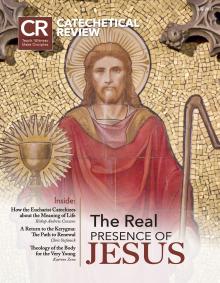The Mass of St. Gregory depicts a miracle in the life of Pope St. Gregory the Great, who died in Rome on March 12 of AD 604. According to tradition, he and others experienced the appearance of Jesus as the pope celebrated a particular Mass. It is considered a eucharistic miracle because of the circumstances surrounding the event.
We learn of this narrative through the stories of the saints collected and published by Jacobus de Voragine, a Dominican priest of the thirteenth century. The original title of his book was Readings from the Saints. But over time, the published work attained the title The Golden Legend. His collection was gathered from wide-ranging sources and traditions and underwent many revisions and additions after his lifetime. The stories are not canonical, so we are not obligated to believe the accuracy of the events depicted. But we find many of the narratives are part of our Catholic devotional love of the saints—they are tales that have been in the minds and hearts of Catholics for centuries. We can read of St. Helen finding the True Cross; the story of St. George and the Dragon; the lives of Mary’s mother and father, Anna and Joachim—it is a very long list. On the matter of belief in apocryphal texts, I prefer to offer Fr. Benedict Groeschel’s usual rejoinder to those who disbelieve in miracles: how do you know . . . were you there?
It is possible to find translations of early versions of The Golden Legend that are substantially the “original” form without the addition of later authors, which may give some confidence to those seeking Jacobus de Voragine’s personal contribution to the collection.
The translation of the original version of the St. Gregory narrative describes the story in this way:
A certain woman used to bring altar breads to Gregory every Sunday morning, and one Sunday when the time came for receiving Communion and he held out the Body of the Lord to her, saying: “May the Body of Our Lord Jesus Christ benefit you unto life everlasting,” she laughed as if at a joke. He immediately drew back his hand from her mouth and laid the consecrated Host on the altar, and then, before the whole assembly, asked her why she had dared to laugh: “Because you called this bread, which I made with my own hands, the Body of the Lord.” Then Gregory, faced with the woman’s lack of belief, prostrated himself in prayer, and when he rose, he found the particle of bread changed into flesh in the shape of a finger. Seeing this, the woman recovered her faith. Then he prayed again, saw the flesh return to the form of bread, and he gave Communion to the woman.[1]
The rest of this online article is available for current Guild members.
This article is from The Catechetical Review (Online Edition ISSN 2379-6324) and may be copied for catechetical purposes only. It may not be reprinted in another published work without the permission of The Catechetical Review by contacting [email protected]

















